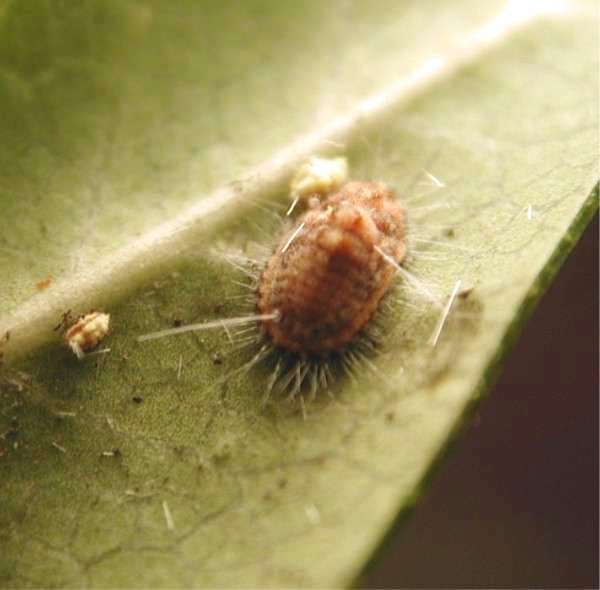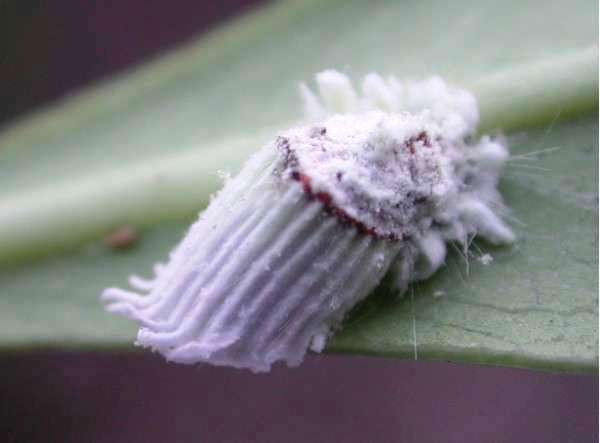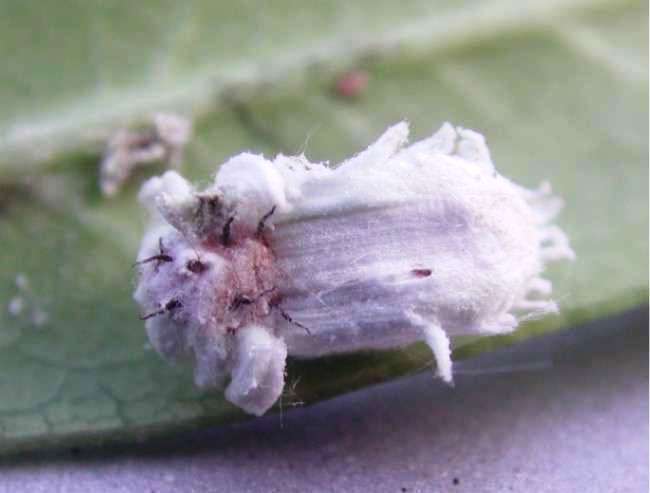
Copyright 2003, David L. Green Unauthorized use prohibited
Cottony Cushion Scale
The pest that launched a revolution in pest control methods
August 10, 2003

Copyright 2003, David L. Green
Unauthorized use prohibited
While I was at the bank (here in South Carolina), I noticed that hundreds of yellow jackets, a few polistes wasps, and an occasional hornet were flying in and out of a Pittosporum bush. I started looking at the leaves to see why the wasps were interested, and I found this reddish brown bug on the bottom of a leaf.
It is a scale insect called cottony cushion scale, or Icerya purchasi. These creatures can move around when they are young, but soon attach themselves to a leaf and begin to make waxy fibers that cover them and their egg cases completely. In the photo above, you can see some of these waxy fibers, so this female has already stopped moving and stationed herself at one spot, where she'll suck out plant juices and lay her eggs.

Copyright 2003, David L. Green Unauthorized
use prohibited
Now you can see a female above at a later stage. The bug is at the upper right, almost covered by the white wax fibers, but you can still see tiny parts of her reddish body. The long capsule at the lower left of her is her egg case. It is fluted, or grooved, like the columns on a public building. Inside are many eggs.

Copyright 2003, David L. Green Unauthorized
use prohibited
I pulled one of these insects from her leaf and turned her over. Her legs are waving feebly, but she is helpless to do anything.
Before 1868, this insect did not exist in North America. It was accidentally brought here that year from Australia on a shipment of plants to California. Soon the cottony cushion scale discovered the orange groves and began to increase rapidly. Because it grew to such great numbers, and sucked so much of the plant juices from the orange trees, the trees did not produce fruit. In fact some orange trees died. The growers lost a lot of money from the lost crops and the dead trees in the groves.
Cottony cushion scale is not a bad pest in Australia, but it quickly became a very bad pest in California. Agricultural experts reasoned that there must be something in Australia that controlled its population there. So a search began for the control agent, and in 1888, a scientist named Albert Koebele discovered an Australian lady bug eating cottony cushion scale in a garden in Adelaide.
American lady bugs didn't pay too much attention to cottony cushion scale, but this Australian lady bug, called Rodolia cardinalis, just loved to munch on cottony cushion scale insects for breakfast, lunch, and supper. This beetle (yes a lady "bug" is actually a beetle) was brought to California and released in the orange groves. Within a year, most of the cottony cushion scale insects were eaten and the orange groves and their crop were saved.
Cottony cushion scale insects were not all killed. A few survived and they have spread to many other areas. But the Australian lady bugs went along too, and it kept them from becoming numerous enough to be a serious pest in other areas. I did not see any ladybugs here on this bush. I will keep watch. The wasps may be helping by eating the scale insects, but more likely they are getting honeydew, sweet secretions that the scale insects secrete.
One predator was very much in evidence and should be helping to control the scale. That is the assassin bug seen below. Her name is Zelus biloba.

Since then scientist have learned how to control many other insects with other insects that eat them, or that lay eggs in them so that their young can eat them from the inside. For example, tomato and tobacco hornworms are often seen with pupae of their parasites lining their back. The worms can be controlled by a tiny wasp that does this.
Controlling pest bugs with other bugs is a special scientific field called "biological control." It's been happening naturally on planet earth for a very long time, but now you know the story of how humans began to use this as a scientific technique to control insect pests.
Links for more info:
Biological and Integrated Pest Control University of California For Serious Students!